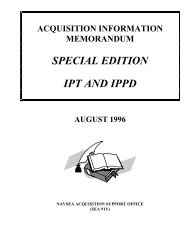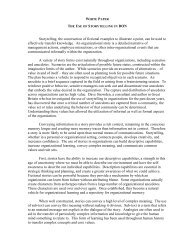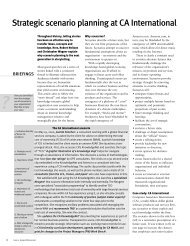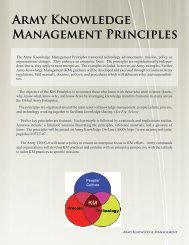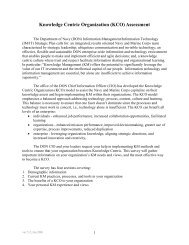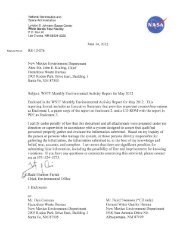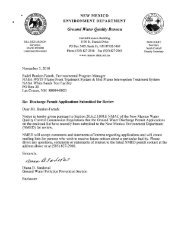NAVAL AVIATION SYSTEMS - NASA Wiki
NAVAL AVIATION SYSTEMS - NASA Wiki
NAVAL AVIATION SYSTEMS - NASA Wiki
Create successful ePaper yourself
Turn your PDF publications into a flip-book with our unique Google optimized e-Paper software.
CHAPTER XI: KEY TOPICS<br />
PART P: HUMAN-SYSTEM INTEGRATION POLICY<br />
Purpose: To briefly explain the purpose of Human-System Integration (HSI) and to describe the current status of<br />
the NAVAIR HSI process.<br />
Source Documents: DoDD 5000.1; DoDI 5000.2, Part 7, Section B; SECNAVINST 5000.2A, Part 24, Attachment<br />
1; OPNAVINST 5000.42D.<br />
Discussion: The following is a formal statement of the purpose of HSI: "To influence system design and<br />
associated support requirements so that developmental, nondevelopmental, and product-improved systems can be<br />
operated and maintained in the most cost-effective and safest manner consistent with manpower structure,<br />
personnel aptitude and skill, and training resource constraints." This statement implies several relevant technical<br />
disciplines, i.e., manpower, personnel, training, human factors, safety, health hazards, and environmental<br />
concerns. Before the reader turns the page with a carefree thought to "we're okay, we're already doing that," let's<br />
look at existing policy, what it's really asking us to do, and what is new.<br />
What is new is the recognition that these disciplines are intimately and intricately interrelated and must be among<br />
the primary drivers of design to ensure our products are not only effective, safe, and supportable, but are also costeffective.<br />
To appreciate this last aspect of the requirement, consider the connections among the following rules of<br />
thumb. First, approximately 70 percent of the decisions that commit life cycle costs are made by Milestone I.<br />
Also, most life cycle costs are incurred during operation and support (O&S) phases. Finally, nearly 50 percent of<br />
those O&S costs are incurred by human-related resource requirements (manpower, personnel, training,<br />
safety/health). Clearly, in addition to enhancing effectiveness and safety, DoD is asking us to employ a disciplined<br />
approach early in the acquisition process to reduce or minimize this major source of O&S cost. HSI is that<br />
approach.<br />
What is really new is the overt, systematic INTEGRATION requirement and the TIMING of the integration. HSI<br />
policy asks us to integrate the human-centered disciplines identified above among themselves and into the entire<br />
design process, beginning at program inception. The idea is to explicitly define HSI constraints (manpower,<br />
personnel, training, human performance, health hazards, and environmental constraints) early in the program,<br />
then actively employ human engineering disciplines throughout the acquisition process to develop a product that is<br />
operable and supportable within those constraints.<br />
Does HSI work? Although HSI is new to NAVAIR, the U.S. Army has employed an HSI process for almost ten<br />
years. As applied to their Comanche Aircraft Program, they recently published a report estimating 3.3 BILLION<br />
DOLLARS cost avoidance due to HSI efforts.<br />
Status: Efforts to develop a NAVAIR HSI process began in July 1994. A NAVAIR HSI Coordinator was<br />
identified and tasked to develop the process and supporting policy, guidance, and training. This function<br />
originated as a special project under the Naval Aviation Safety Department (AIR-8.0H) but was recently<br />
transitioned to the Policy and Standards Office (AIR-4.1C). A NAVAIR HSI Working Group meets weekly to<br />
define a practical, flexible process and to discuss organizational and technical issues. However, no official policy<br />
or guidance has been issued as of this writing. An HSI training course for technical personnel was delivered<br />
November 1994 and additional training is scheduled for Spring 1995.<br />
However, much to the alarm of many programs, the lack of an official NAVAIR HSI process does not preclude the<br />
requirement! HSI applies to all ACAT programs, regardless of the acquisition phase. DoD policy directs HSI<br />
considerations, implementation strategy, and output to be documented in an HSI Plan and incorporated in the<br />
Mission Need Statement, Operational Requirements Document, Request for Proposal, Test and Evaluation Master<br />
Plan, and Integrated Program Summary. Assistance is available through the NAVAIR HSI Coordinator listed as<br />
the POC below.<br />
69



